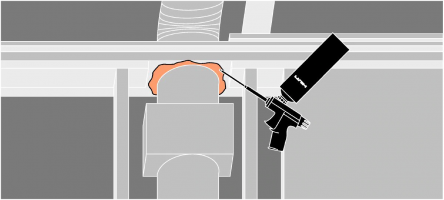What are you accepting in the way of sealing up penetrations through fire blocking?
In particular, for commercial wood-frame buildings (Type V-B or other) where you have pipes and wires that penetrate your sole or top plate of the wall, how do you seal around the penetrating item? As an example, think of an interior load bearing wall in an apartment building. Wiring or plumbing comes from under the slab, runs up through the wall, then either continues into a wall above, or runs horizontally through the floor. No penetration through GWB (thus no through or membrane penertation) has been made, therefore no fire-stopping. Only the plate, which serves as fire-blocking, has been penetrated.
For us, the fire-foam is a no go. It will fly in residential (not preferred) as the can has a listing on it approving it for residential use; but for said reason, we do not accept it in commercial buildings (apartments, hotels/motels, office buildings, etc.).
Fire-stopping (fire-caulk or other) is only required for membrane or through penetrations of a rated assembly. A pipe or wire traveling vertically may not penetrate through the sheetrock and does not therefore meet the intent of a membrane or through penetration. Per IBC Section 714.1, said section, which stipulates the use of fire-stopping, does not pertain to non-rated walls.
714.1 seems to indicate all of 714 is out of context if not penetrating a horizontal assembly or a fire-resistance-rated wall assembly; however, 714.5 speaks of penetrating nonfire-resistance rated floor or floor/ceiling assemblies.
718.2 really does not provide much other than saying that the integrity of fireblocks must be maintained.
714.1 Scope
The provisions of this section shall govern the materials and methods of construction used to protect through penetrations and membrane penetrations of horizontal assemblies and fire-resistance-rated wall assemblies.
714.5 Nonfire-Resistance-Rated Assemblies
Penetrations of nonfire-resistance-rated floor or floor/ceiling assemblies or the ceiling membrane of a nonfire-resistance-rated roof/ceiling assembly shall meet the requirements of Section 713 or shall comply with Section 714.5.1 or 714.5.2.
714.5.1 Noncombustible Penetrating Items
Noncombustible penetrating items that connect not more than five stories are permitted, provided that the annular space is filled to resist the free passage of flame and the products of combustion with an approved noncombustible material or with a fill, void or cavity material that is tested and classified for use in through-penetration firestop systems.
714.5.2 Penetrating Items
Penetrating items that connect not more than two stories are permitted, provided that the annular space is filled with an approved material to resist the free passage of flame and the products of combustion.
718.2.1.4 Fireblocking Integrity
The integrity of fireblocks shall be maintained.
In particular, for commercial wood-frame buildings (Type V-B or other) where you have pipes and wires that penetrate your sole or top plate of the wall, how do you seal around the penetrating item? As an example, think of an interior load bearing wall in an apartment building. Wiring or plumbing comes from under the slab, runs up through the wall, then either continues into a wall above, or runs horizontally through the floor. No penetration through GWB (thus no through or membrane penertation) has been made, therefore no fire-stopping. Only the plate, which serves as fire-blocking, has been penetrated.
For us, the fire-foam is a no go. It will fly in residential (not preferred) as the can has a listing on it approving it for residential use; but for said reason, we do not accept it in commercial buildings (apartments, hotels/motels, office buildings, etc.).
Fire-stopping (fire-caulk or other) is only required for membrane or through penetrations of a rated assembly. A pipe or wire traveling vertically may not penetrate through the sheetrock and does not therefore meet the intent of a membrane or through penetration. Per IBC Section 714.1, said section, which stipulates the use of fire-stopping, does not pertain to non-rated walls.
714.1 seems to indicate all of 714 is out of context if not penetrating a horizontal assembly or a fire-resistance-rated wall assembly; however, 714.5 speaks of penetrating nonfire-resistance rated floor or floor/ceiling assemblies.
718.2 really does not provide much other than saying that the integrity of fireblocks must be maintained.
714.1 Scope
The provisions of this section shall govern the materials and methods of construction used to protect through penetrations and membrane penetrations of horizontal assemblies and fire-resistance-rated wall assemblies.
714.5 Nonfire-Resistance-Rated Assemblies
Penetrations of nonfire-resistance-rated floor or floor/ceiling assemblies or the ceiling membrane of a nonfire-resistance-rated roof/ceiling assembly shall meet the requirements of Section 713 or shall comply with Section 714.5.1 or 714.5.2.
714.5.1 Noncombustible Penetrating Items
Noncombustible penetrating items that connect not more than five stories are permitted, provided that the annular space is filled to resist the free passage of flame and the products of combustion with an approved noncombustible material or with a fill, void or cavity material that is tested and classified for use in through-penetration firestop systems.
714.5.2 Penetrating Items
Penetrating items that connect not more than two stories are permitted, provided that the annular space is filled with an approved material to resist the free passage of flame and the products of combustion.
718.2.1.4 Fireblocking Integrity
The integrity of fireblocks shall be maintained.

